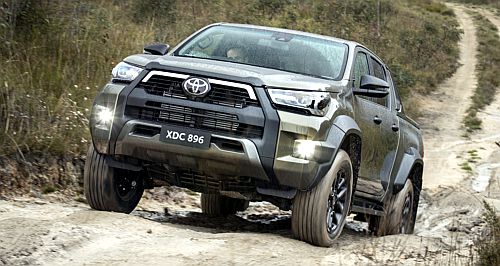News - VFACTS - Sales 2022VFACTS: 2022 sales top the million markON TOP AGAIN: Toyota's HiLux has again climbed to the top of Australia's annual sales ladder, outpacing a wide range of light commercial, SUV and passenger models. New car sales strong despite ongoing supply chain and delivery issues5 Jan 2023 By MATT BROGAN AUSTRALIA’S automotive industry delivered more than one million new cars to customers nationally in 2022 despite ongoing supply chain and delivery issues caused by the COVID-19 pandemic.
According to the FCAI, a total of 1,081,429 vehicles were delivered during a year where demand exceeded supply – much the same as it did in 2021.
Toyota remains Australia’s top-selling car brand with 21.4 per cent of the market.
Toyota sold 231,050 vehicles across the 2022 calendar year, more than doubling second place Mazda’s 95,718 unit sales. Kia ranked third overall in 2022 with 78,330 unit sales ahead of Mitsubishi (76,991) and Hyundai (73,345).
The top-selling model again in 2022 was the Toyota HiLux, amassing an impressive 64,391 unit sales. The HiLux beat Ford’s Ranger (47,479) and the Toyota RAV4 (34,845) to the podium’s top place with Mitsubishi’s Triton ranking fourth (27,436) and Mazda’s CX-5 in fifth (27,062).
Expectedly, SUV and light commercial vehicles accounted for the majority of vehicle sales in 2022 (76.8 per cent) and comprised eight of the top 10 slots by vehicle category.
Passenger vehicle sales totalled 203,056 units (18.8 per cent), well behind SUV sales of 574,632 units (53.1 per cent), also behind light commercial vehicles with 256,382 unit sales (23.7 per cent). Heavy vehicle sales of 47,321 units (4.4 per cent) round out the difference.
Sales of battery electric vehicles (BEVs) continue to advance, now accounting for 3.1 per cent of all new car sales.
Petrol-powered vehicles remain in the majority, however, with 551,556 unit sales (51 per cent) ahead of diesel (361,366 and 33.4 per cent), hybrid (81,786 and 7.6 per cent), electric (33,410 and 3.1 per cent), and finally plug-in hybrid (5937 and 0.5 per cent) powered vehicles.
For the month of December, a year-on-year increase of 9518 units (or 12.1 per cent) was noted with a total of 87,920 new vehicle sales accrued.
There were 25 selling days in December against 24 in 2022, resulting in an increase of 250.1 vehicle sales per day according to the FCAI.
Interestingly, the passenger vehicle market is up by 445 vehicle sales (3.1 per cent) over the same month last year, while the SUV market grew 8746 units (or 21.7 per cent).
Light commercial vehicle sales were down slightly (-371 units and -1.9 per cent), while heavy commercial vehicle sales rose considerably, up 698 units (or 19.2 per cent). Versus December 2021.
Toyota was again Australia’s most popular vehicle brand in December, leading Mazda by 7774 units and 8.8 market share points. However, the Toyta HiLux was beaten by Ford’s Ranger in December, the Blue Oval recording 4663 unit sales over the Big T’s 4271.
Speaking on the success of sales through 2022, FCAI chief executive, Tony Weber, said the pathway through the pandemic recovery, microprocessor shortage and supply bottlenecks had posed great challenges for manufacturers and their dealer networks.
“While 2022 has been a year of resilience and recovery, 2023 is shaping up as one of the most significant in recent history, particularly in terms of the development of policies that set the direction for the future decarbonisation of the light vehicle fleet,” he said.
“As the peak representative body for vehicle distributors, FCAI has advocated for a fuel efficiency standard for many years.
“We are optimistic that the Federal Government will take action in 2023 and introduce a standard that achieves the policy outcomes that lead to emission reductions while enabling Australians to drive the vehicles that they need and want.
“The FCAI and its members will do all it can to promote the development of sound policy, based on solid data and in the context of the unique nature of the Australian market.”
Continuing, Mr Weber said that beyond the fuel efficiency standard, a technology mix, infrastructure investment and behaviour change initiatives were also needed to reduce emissions to create a cleaner fleet and ensure a sustainable automotive industry.
“We need to use the full range of low emission technologies that are available and affordable for the majority of Australians, not just those who can afford premium vehicles,” he said.
“As vehicle technology develops beyond matters of safety and performance, the industry is dealing with the complexities of increased connectivity of vehicles to broader infrastructure and information networks.
“Other areas of focus include ports and logistics, design regulations and matters relating to future road user charges as fuel excise starts to fall with the increase of zero and low emission vehicles on our roads.
“The FCAI recognises there will be significant challenges and opportunities in the year ahead and will be working with government, consumers and our members to overcome the challenges and capitalise on the opportunities in a way that benefits our planet, industry and drivers.”
Top 10 vehicle sales by make (December 2022):
Sales volume by model (December 2022):
State-by-state (December 2022):
Top 10 vehicle sales by make (2022):
Sales volume by model (2022):
 Read more |
Click to shareVFACTS articlesResearch VFACTS Motor industry news |

















Facebook Twitter Instagram